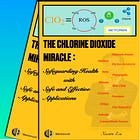This excerpt is from my book, "The Chlorine Dioxide Miracle: Safeguarding Health with Safe and Effective Applications." If you're interested in chlorine dioxide therapy, you can purchase the book here:
8.1 Dry Eye Syndrome and Chlorine Dioxide
Dry Eye Syndrome (DES) is a common ocular condition involving tear production and tear film stability, affecting eye comfort and visual performance. It can be caused by various factors, including aging, hormonal changes, environmental influences, side effects of medications, certain medical conditions, or eye surgery.
Etiology: The onset of dry eye can generally be attributed to two main categories: decreased tear production and increased tear evaporation. Decreased tear production may be due to lacrimal gland dysfunction, which can be associated with autoimmune diseases (such as Sjögren’s syndrome) or other systemic conditions. Increased tear evaporation is often related to eyelid margin diseases (such as blepharitis or styes), eyelid structural abnormalities, incomplete blinking, or prolonged exposure to computer screens.
Symptoms: Symptoms of dry eye are varied and can include dryness, pain, a burning sensation, the feeling of a foreign body in the eye, blurred vision, and fatigue. Some patients may also experience excessive tearing as the eyes try to compensate for the dryness. Additionally, symptoms can be exacerbated by environmental factors such as wind, low humidity, smoke, or air-conditioned environments.
Diagnosis: The diagnosis of dry eye is typically based on symptoms, medical history, and a series of ophthalmologic examinations. Doctors may test tear production, such as with the Schirmer test, and measure tear film break-up time (TBUT) to assess the quality and stability of the tear film. Additionally, special dyes may be used to examine damage to the ocular surface.
The treatment of dry eye aims to restore ocular lubrication and alleviate symptoms. Treatment options include:
(1) Environmental and Lifestyle Adjustments: Using humidifiers, avoiding direct air conditioning, reduc Artificial Tears: Using preservative-free artificial tear eye drops can provide temporary relief.
(2) Tear Conservation: Small surgical procedures to block the tear ducts can reduce tear drainage to keep the eyes moist.
(3) Eyelid Hygiene: Regular cleaning of the eyelid margins, using warm compresses and massage, can help improve oil secretion.
(4) Medications: Anti-inflammatory medications such as cyclosporine eye drops or oral Omega-3 fatty acid supplements may help reduce inflammation.
(5) Reducing screen time, and taking regular breaks can help alleviate symptoms.
Experience in treating dry eye has taught us that it is a difficult condition to cure. I have personally used chlorine dioxide for self-treatment on several occasions, after which there were no recurrences. In my analysis, research on chlorine dioxide may reveal its dual role: on one hand, it stimulates tear secretion, alleviating symptoms of dry eye; on the other hand, chlorine dioxide may have immunomodulatory capabilities. Upon contact with the conjunctiva, it can suppress inflammatory responses, helping to restore immune system balance.
8.2 Dry Eye Syndrome Treatment Protocol
A. Preparation of Chlorine Dioxide:
Weigh out 100 grams of sodium chlorite solid (powder form, 80% purity, with the remaining 20% being sodium chloride). Add this to 900 milliliters of deionized (or distilled) water. Heat the mixture to about 50 degrees Celsius until the solid is completely dissolved, then allow it to cool to room temperature. This creates an 8% sodium chlorite solution.
Weigh out 200 grams of citric acid (analytical grade, 99.9% purity) and add it to 800 milliliters of deionized (or distilled) water. Heat the mixture to about 50 degrees Celsius until the solid is fully dissolved, forming a 20% citric acid solution.
Mix equal volumes of the two solutions prepared above and wait for approximately 5 minutes to produce a saturated solution of acidic chlorine dioxide (about 3000 ppm or 3 mg/mL).
B. Method of Use for Treating Dry Eye Syndrome:
Position the prepared chlorine dioxide solution below the eye, ensuring the bottle opening is directed towards the eye, and allow the chlorine dioxide to come into contact with the eye through its natural evaporation. This fumigation method enables the chlorine dioxide to contact the conjunctiva. Given the strong irritant nature of chlorine dioxide to the eyes, the fumigation process should not exceed 15 seconds. If discomfort occurs, cease immediately. Repeat this fumigation process 3 to 5 times a day, and do not continue for more than 5 days. It is crucial to avoid direct contact between the chlorine dioxide solution and the eyes.






Is it safe to use if one has had cataract surgery?